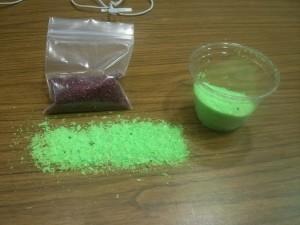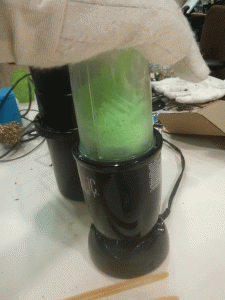The recycling of plastics and 3D printed objects is something that has garnered a ton of attention over the last year or two. With 3D printers becoming ever more popular, there are environmental consequences to the  increase of plastics being manufactured and subsequently thrown away in our landfills. This has led several groups to try and figure out a way in which unwanted 3D printed items, or even plastics we come upon in our daily lives, can easily be reused instead of trashed.
increase of plastics being manufactured and subsequently thrown away in our landfills. This has led several groups to try and figure out a way in which unwanted 3D printed items, or even plastics we come upon in our daily lives, can easily be reused instead of trashed.
In order to recycle PLA filament, one must first grind the filament up into tiny pieces. Once done, that filament can be placed into a plastic extruder, melted, and turned back into 3d printer filament. The problem is it often takes a tremendous amount of work and energy to chop the plastic up fine enough, mostly due to the fact that the PLA plastics absorb energy, making them difficult to break down.
This is why University of British Columbia students, with the UBC Rapid engineering design team, have been working to find a better way to grind plastics. They have  recently figured out a way to better grind up PLA 3D printer plastic via a household blender, by adding liquid nitrogen to the mix.
recently figured out a way to better grind up PLA 3D printer plastic via a household blender, by adding liquid nitrogen to the mix.
PLA plastic has a brittle transition temperature that is under -20 to -40C. This means that at those temperatures, the plastic loses most if its energy absorbtion properties, basically allowing it to shater as blender blades hit it. Liquid nitrogen has a temperature far colder (-196C) than the brittle transition temperature required, making it ideal for cooling the plastic. What the team at UBC Rapid did was cool the plastic with the liquid nitrogen, strain the liquid out of the plastic, place the plastic into a Magic Bullet blender, and blend away. The results were quite remarkable, leaving the team with an almost powder like material after only a few minutes in the blender. The blended material can then be placed into an extruder and made into filament for your favorite 3D printer.
There are some caveats here though. It is not easy to just go pick up liquid nitrogen. This is where dry ice could come into play. Although the ice is not as cold as the nitrogen, it is still well below the temperature needed to eliminate the energy absorbtion properties of the plastic. The other caveat is that temperatures this cold will also cause metals, like the blender blades, to become more brittle, leading to broken blades in some cases. Either way this research may pave the way towards a more large scale PLA recycling project. Discuss this unique approach to the recycling of PLA filament at 3D Print Board.
Subscribe to Our Email Newsletter
Stay up-to-date on all the latest news from the 3D printing industry and receive information and offers from third party vendors.
You May Also Like
Printing Money Episode 17: Recent 3D Printing Deals, with Alex Kingsbury
Printing Money is back with Episode 17! Our host, NewCap Partners‘ Danny Piper, is joined by Alex Kingsbury for this episode, so you can prepare yourself for smart coverage laced...
3DPOD Episode 198: High Speed Sintering with Neil Hopkinson, VP of AM at Stratasys
Neil Hopkinson, a pioneering 3D printing researcher, played a pivotal role in developing a body of research that is widely utilized today. He also invented High Speed Sintering (HSS), also...
3DPOD Episode 197: Ceramics 3D Printing with Johannes Homa, Lithoz CEO
Lithoz is a pioneer in the 3D printing of technical ceramics, initially using a ceramic-loaded stereolithography process and later adopting multiple technologies. Johannes Homa, a researcher turned entrepreneur, discusses his...
High Stakes, High Speed: KVG Acquires 15 Nexa3D HSE 3D Printers to Boost Military Tech
As 3D printing increasingly intersects with defense and military logistics, a new partnership between Nexa3D and mission support logistics firm KVG stresses the growing importance of this technology in strategic...
































